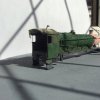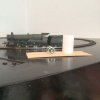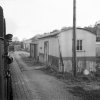Morning all.
Just thinking out loud again, so sorry to disappoint anyone looking for a bit of progress

But nobody’s as disappointed as me at this forced inertia.
Now that I’ve made the change from Downtown LA to the green, green grass of home, thoughts have turned to the track plan.
Lack of space dictates that the run-round loop will remain just that, and not a full passing loop reminiscent of many country, single-tracked branch lines. However, that single siding has to be addressed in terms of safety alone; not only would the Disused tramway have had to be protected from runaways, but also the main line, obviously still in use at this time. To this end, I’m thinking of employing a catch-point, and as I recall, I may have just the ticket in the odds ‘n’ sods box ( it’s also another lame excuse to dig out an old photo):

I was contemplating building one from scratch using some left over plastic chairs from a C&L point kit, together with some veneer sleepers or some ply jobbies from C&L. However, in my limited experience, I find the stock rails being forced outwards as the switch rail hits home, so I’m really not sure about the longevity of points built with this method. Perhaps a hybrid method using the existing point with ply and plastic chairs employed here and there just for aesthetic reasons? Wire-in-tube using angle cranks (either GEM or home made) would be the choice of operation; the tubes being recessed and taken through a hole in the backscene, to be operated by hand from the rear. Btw, that outside rail extends too far and will need cutting back.
The mainline will also be punctuated with C&L chairs and ply sleepers, the pcb sleepers remaining to provide rigidity and maintain gauge.
Turning to signalling, I’m hoping that the project might also find a use for this:


It’s based on a photo in Stephen Williams’ first tome, and believe it or not, it’s designed to work, although the operating wires were removed when this photo was taken. A weighted bar still needs to be fashioned, my intention having been to modify the arm that comes with the Ratio GWR signal kit.
The post carrying the arm pivot is a bit of an eye sore (it’s all I had in the odds box) but I’m thinking of disguising it as some sort of hydrant-with-hose. Dunno. More thought required there me thinks. Not sure if anyone would notice it anyway due to its minuscule proportions.
Well that’s it for now, but I hope nobody minds me posting as and when thoughts/ waffle/developments arise.
Best wishes,
Jonte














 . Still, the six- coupled steamers should be okay, as this photo of me running-in a Hornby Grange testify to (a purchase intended for conversion to P4 and still on the to-do list):
. Still, the six- coupled steamers should be okay, as this photo of me running-in a Hornby Grange testify to (a purchase intended for conversion to P4 and still on the to-do list):









